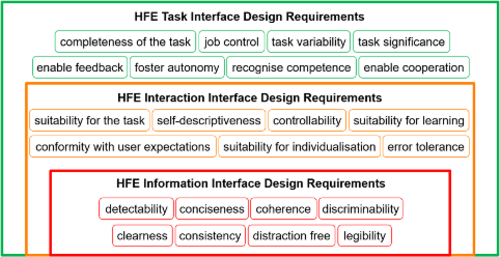General Information Design Principles
The design process for human-system interaction includes three different but interrelated interfaces, i.e., the task, the interaction, and the information interface.
Task interface design
- requires analysis of and serves system goals, functions, activities, and information required.
- allocates functions to operator and/or to technical components of a work system (e.g., machinery).
- covers task requirements for system design.
Interaction interface design
- interfaces the human operator for task interactions (e.g., dialogue) with the technical system.
- respects human performance capabilities and limitations while at the same time considering principles of human information processing.
Information interface design
- covers information modalities (e.g., visual), objects (e.g., text) and passive or active (e.g., label, control, feedback) impacts on human information processing.
The selection of design requirements as presented in Figure 1 refer to the design of interfaces and support human factors and ergonomics as well as occupational safety and health in work system design.
Information interface design
Designing the information interface refers to modalities (e.g., visual, auditory, haptic), objects (e.g., text, graphic, list, display) and may be passive or active (e.g., label, control, feedback). It is closely linked to human information processing as it influences reasoning and decision making while directly linking to perception (ascribe meaning) and action implementation (feedback).
Information presentation supports information flow by guiding the operators in a direction.
Please select among the following information interface design requirements to get more information:
- Detectability
- Conciseness
- Coherence
- Discriminability
- Clearness
- Consistency
- Distraction free
- Legibility
References
- EN 614-2 (2008). Safety of machinery – Ergonomic design principles – Part 2: Interactions between the design of machinery and work tasks. Brussels: CEN.
- EN 894-1 (2010). Safety of machinery – Ergonomics requirements for the design of displays and control actuators – Part 1: General principles for human interactions with displays and control actuators. Brussels: CEN.
- EN 894-3 (2008). Safety of machinery – Ergonomics requirements for the design of displays and control actuators – Part 3: Control actuators. Brussels: CEN.
- EN 894-4 (2010). Safety of machinery – Ergonomics requirements for the design of displays and control actuators – Control actuators – Part 4: Location and arrangement of displays and control actuators. Brussels: CEN.
- Kantowitz, B.H., Sorkin, R.D. (1983). Human factors: Understanding people-system relationships. New York: Wiley.
- Wickens, C.D., Hollands, J.G., Banbury, S., Parasuraman, R. (2013). Engineering Psychology and Human Performance. Upper Saddle River: Pearson.


